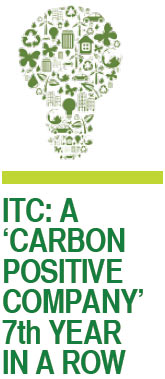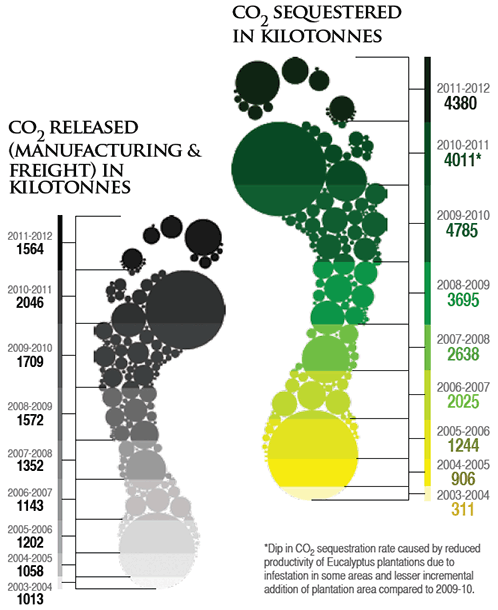Environmental Performance
Climate Change and Sustainable Development
 Minimising Carbon Intensity and Adopting a Low Carbon Growth Path
Minimising Carbon Intensity and Adopting a Low Carbon Growth Path
 In the Hotels Business, significant improvements in specific energy consumption have been achieved by ITC Gardenia (28%) and ITC Windsor (17.4%).
In the Hotels Business, significant improvements in specific energy consumption have been achieved by ITC Gardenia (28%) and ITC Windsor (17.4%).
The Leaf Threshing Unit in Anaparti also reduced its specific energy consumption by 17.5% over the previous year.
Other Units which performed remarkably in improving specific energy consumption over the previous year are:
| Cigarette Unit at Kolkata | 8.6% |
| Cast Coating Unit at Bollaram | 8.7% |
| Packaging & Printing Unit at Tiruvottiyur | 13.3% |
Additional data on energy conservation measures implemented by ITC units are available at www.itcportal.com under Report and Accounts 2012.
ITC has registered several Clean Development Mechanism (CDM) projects with UNFCCC (United Nations Framework Convention on Climate Change) under the Kyoto Protocol. In addition, a number of projects are in various stages of registration with the CDM Board or in the voluntary carbon markets. These projects besides reducing greenhouse gas emissions have also helped ITC offset some of the investments made towards reducing specific energy consumption and enhancement of the renewable energy portfolio through the sale of carbon credits.
In addition, we are well positioned to leverage other opportunities that lie in India specific schemes which are on the anvil, such as Perform, Achieve and Trade (PAT) or Renewable Energy Certificates (RECs) promoted by the Government of India.

Enlarging ITC’s Carbon Positive Footprint
In 2011-12, ITC’s operations (manufacturing & freight) generated total CO2 emissions of 1,564 Kilotonnes (2,046 Kilotonnes in 2010-11). The reduction in energy consumption and associated CO2 emissions primarily reflects energy efficiency measures taken and revisions in computation of calorific value of fuel which the organisation has adopted in order to conform to the ISO 14064 standard. The reduction in emissions is also due to the increased contribution from renewable energy sources. The total emissions, estimated in accordance with the GRI-G3 reporting framework, include 1,157 Kilotonnes of CO2 emissions arising from use of direct energy (Scope 1), 160 Kilotonnes from purchased electricity (Scope 2) and 247 Kilotonnes emitted due to transportation of materials and products (Scope 3).
ITC’s Social and Farm Forestry Initiatives added more than 11,000 hectares of plantations during 2011-12. Total plantations as on March 31, 2012, now stand at over 125,000 hectares. The Social and Farm Forestry Initiatives have not only contributed to sustainable source of raw material for the Paperboards Business, but has also helped sequester additional 4,380 Kilotonnes of CO2 in this year, thus consolidating ITC’s status as a ‘Carbon Positive Company’ for the seventh year in a row. The Social and Farm Forestry Programmes have also provided 56.2 million person-days of employment to date for small and marginal farmers.